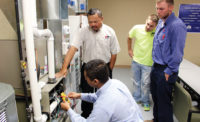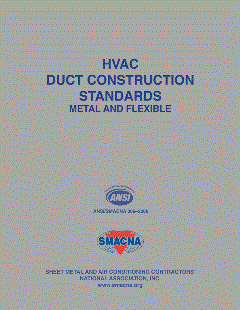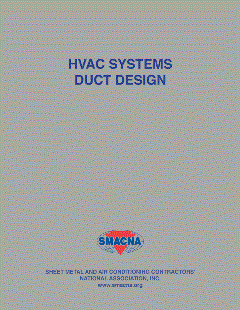Recognizing Innovation
The Sheet Metal and Air Conditioning Contractors' National Association’s (SMACNA’s) Arizona chapter awarded Scott Bohlman and Mike Tucci of Dynamic Systems a $1,000 cash prize for winning SMACNA Arizona’s Annual Innovation Award. The craftsmen were recognized for their innovative approach in the development of a way to ship and quickly offload ductwork from a 53-foot closed-container truck onto a platform. The pair created reusable assemblies, or duct racks that are shipped back to the fabrication facility for future loads. Their solution eliminated the need for a forklift and ground crew, thus reducing safety hazards associated with the unloading process while significantly reducing the man-hours needed for the job.
Bohlman and Tucci are journeymen sheet metal workers at the company. They worked with Kevin Huber, labor manager, to come up with a better way to ship, receive, and then off-load 10-foot-long, 46-inch-diameter, heavy-duty duct sections for a major installation of mechanical systems at Intel fab, a computer chip facility in the Phoenix area. Dynamic Systems utilized coated stainless steel duct for acid and ammonia systems from Viron International and galvanized duct for general exhaust from the plant and VOC exhaust from United McGill.
Finding a Solution
Initially, the duct was shipped in wooden pallets. Oftentimes, the product would be damaged during shipment and require rework before it went to the Intel fab. Upon arrival at the facility, it had to be unloaded, placed on lifts, transferred to other forklifts on the second story of the facility, and moved again. This was a tedious two- to three-hour process requiring three or four workers.
Bohlman and Tucci came up with the original concept of fabricating unistrut racks that would support the ends of the ducts and using the flanges of the ducts to bolt them to the struts (see Figure 1). Their design also included wheels mounted to the struts so they could easily be wheeled out of the truck and quickly moved into place at the fab. They took their idea to Huber, who added some refinements and took advantage of one of the company’s CAD systems to design the products. The prototypes were fabricated in the shop at Dynamic Systems. Modifications were required to reinforce the wheels, Huber said, “Because of the weight of the ducts, the wheels wanted to roll under so we had to put an angle iron on them to give them more support.”
The mobile duct rack systems have enabled Dynamic Systems to unload an entire 53-foot trailer and wheel the ducts into and through the fab without the use of forklifts. Not only did this innovative idea save hours of time for each truck, it eliminated the need for a four-man crew. Huber calculated this has saved his company over 1,000 man-hours, has cut down on damaged products, and has improved worker safety.
The idea was so successful that Dynamic Systems fabricated over 200 sets of struts for use with Viron and United McGill. This was necessary because the job was so massive that it required over 100 truckloads of material from each of the suppliers. According to Ted Buescher, district sales manager at McGill Air Flow, a division of United McGill, “There were some minor problems with the initial racks. After two or three loads, we worked out the problems and the rest of the job just went … sweet. We were able to place four 10-foot ducts on a rack and then fit five racks in a trailer. It was just an incredible idea.”
Expanding Applications
There should be a lot of applications for mobile rack systems like those conceived by Bohlman and Tucci. According to Huber, “It could work on just about anything. You just need to be aware of the weight radians and make sure the wheels are rated for it.”
He added, “It’s expensive initially to build the racks, but I think we are going to start seeing more and more of them, especially on industrial-type jobs that require large, heavy-duty ducts. Not only does it improve the material handling, but it improves safety because you don’t have guys in a trailer trying to unload different levels of material.”
Publication date: 10/15/2012






